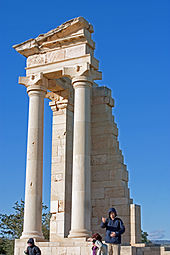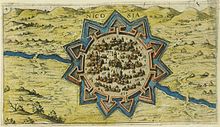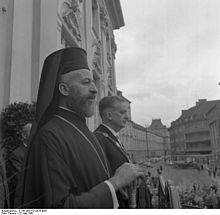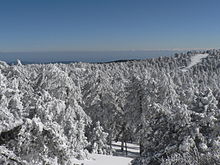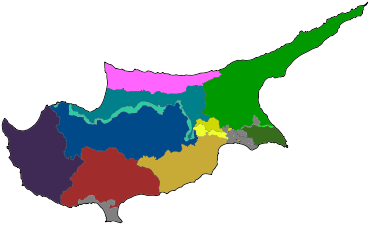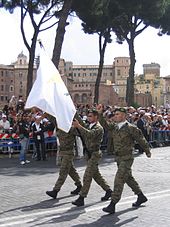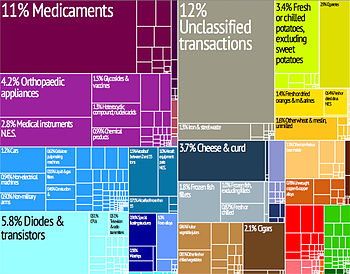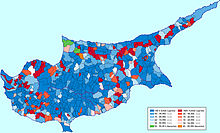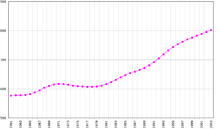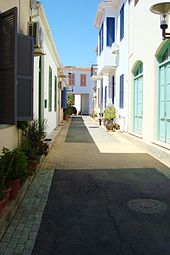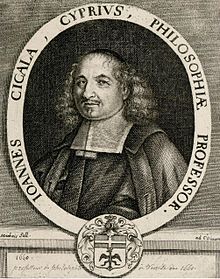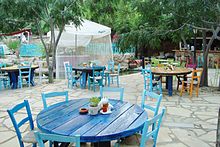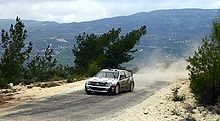
Cyprus
Background to the schools Wikipedia
This wikipedia selection has been chosen by volunteers helping SOS Children from Wikipedia for this Wikipedia Selection for schools. Visit the SOS Children website at http://www.soschildren.org/
| Republic of Cyprus | ||||||
|---|---|---|---|---|---|---|
|
||||||
| Anthem: Ὕμνος εἰς τὴν Ἐλευθερίαν (Greek) |
||||||
|
Location of Cyprus (dark green)
in the European Union (light green) — [Legend] |
||||||
| Capital and largest city |
Nicosia 35°08′N 33°28′E |
|||||
| Official languages |
|
|||||
| Ethnic groups (2001) |
|
|||||
| Demonym | Cypriot | |||||
| Government | Unitary presidential constitutional republic | |||||
| - | President | Nicos Anastasiades | ||||
| Legislature | House of Representatives | |||||
| Independence from the United Kingdom | ||||||
| - | Zürich and London Agreement | 19 February 1959 | ||||
| - | Independence proclaimed | 16 August 1960 | ||||
| - | Independence Day | 1 October 1960 | ||||
| Area | ||||||
| - | Total | 9,251 km2 ( 168th) 3,572 sq mi |
||||
| - | Water (%) | negligible | ||||
| Population | ||||||
| - | 2011 estimate | 1,099,341 ( 159th) | ||||
| - | 2011 census | 838,897 | ||||
| - | Density | 90.7/km2 ( 114th) 234.85/sq mi |
||||
| GDP ( PPP) | 2012 estimate | |||||
| - | Total | $23.752 billion | ||||
| - | Per capita | $28,646 | ||||
| GDP (nominal) | 2012 estimate | |||||
| - | Total | $24.014 billion | ||||
| - | Per capita | $28,961 | ||||
| Gini (2005) | 29 low · 19th |
|||||
| HDI (2013) | very high · 31st |
|||||
| Currency | Euro ( EUR) |
|||||
| Time zone | EET ( UTC+2) | |||||
| - | Summer ( DST) | EEST ( UTC+3) | ||||
| Drives on the | left | |||||
| Calling code | +357 | |||||
| ISO 3166 code | CY | |||||
| Internet TLD | .cy | |||||
|
||||||
Cyprus / ˈ s aɪ p r ə s / (Greek: Κύπρος [ˈcipɾos] Kýpros; Turkish: Kıbrıs [ˈkɯbɾɯs]), officially the Republic of Cyprus (Greek: Κυπριακή Δημοκρατία [cipɾiaˈci ðimokɾaˈti.a] Kypriakī́ Dīmokratía; Turkish: Kıbrıs Cumhuriyeti [ˈkɯbɾɯs d͡ʒumhuɾijeˈti]), is an island country in the Eastern Mediterranean Sea. Cyprus is the third largest island in the Mediterranean Sea after Sicily and Sardinia, and a member state of the European Union. It is located east of Greece, south of Turkey, west of Syria and Lebanon, northwest of Israel and the Gaza Strip, and north of Egypt.
The earliest known human activity on the island dates to around the 10th millennium BC. Archaeological remains from this period include the well-preserved Neolithic village of Khirokitia, which has been declared a World Heritage Site with an "enhanced protection" status in the event of armed conflict by UNESCO, along with the archaeological sites of Paphos and the Painted Churches of the Troodos Region. Cyprus is home to some of the oldest water wells in the world.
Cyprus was settled by Mycenean Greeks in two waves in the 2nd millennium BC. As a strategic, location in the Middle East, it was subsequently occupied by several major powers, including the empires of the Assyrians, Egyptians, and Persians, from whom the island was seized in 333 BC by Alexander the Great. Subsequent rule by Ptolemaic Egypt, the Roman Empire, the Byzantines, Arab caliphates for a short period, the French Lusignan dynasty, and the Venetians, was followed by the Ottoman conquest in 1571. It remained under Ottoman control for over three centuries. Cyprus was placed under British administration in 1878 until it was granted independence in 1960, becoming a member of the Commonwealth the following year.
In 1974, seven years after the intercommunal violence between Greek Cypriots and Turkish Cypriots, an attempted coup d'état by Greek Cypriot nationalists and elements of the Greek military junta with the aim of achieving enosis (union of the island with Greece) took place. Turkey used this as a pretext to invade the northern portion of the island. Turkish forces remained after a cease-fire, resulting in the partition of the island; an objective of Turkey since 1955. The intercommunal violence and subsequent Turkish invasion led to the displacement of over 150,000 Greek Cypriots and 50,000 Turkish Cypriots, and the establishment of a separate Turkish Cypriots political entity in the north. These events and the resulting political situation are matters of ongoing dispute.
The Republic of Cyprus has de jure sovereignty over the island of Cyprus and its surrounding waters, except for the British Overseas Territory of Akrotiri and Dhekelia, administered as Sovereign Base Areas. However, the Republic of Cyprus is de facto partitioned into two main parts; the area under the effective control of the Republic, comprising about 59% of the island's area, and the Turkish-controlled area in the north, calling itself the Turkish Republic of Northern Cyprus and recognised only by Turkey, covering about 36% of the island's area. The international community considers the North as occupied territory of the Republic of Cyprus.
Cyprus is the third most populous island in the Mediterranean Sea and a major tourist destination in the Mediterranean. An advanced, high-income economy with a very high Human Development Index, the Republic of Cyprus was a founding member of the Non-Aligned Movement until it joined the European Union on 1 May 2004. On 1 January 2008, the Republic of Cyprus joined the Eurozone.
Etymology

The earliest attested reference to Cyprus is the 15th-century BC Mycenaean Greek ku-pi-ri-jo, meaning "Cypriot", written in Linear B syllabic script. The classical Greek form of the name is Κύπρος Kýpros.
The etymology of the name is unknown. Suggestions include:
- the Greek word for the Mediterranean cypress tree ( Cupressus sempervirens), κυπάρισσος (kypárissos)
- the Greek name of the henna plant (Lawsonia alba), κύπρος (kýpros)
- an Eteocypriot word for copper. Georges Dossin, for example, suggests that it has roots in the Sumerian word for copper (zubar) or for bronze (kubar), from the large deposits of copper ore found on the island.
Through overseas trade, the island has given its name to the Classical Latin word for copper through the phrase aes Cyprium, "metal of Cyprus", later shortened to Cuprum.
Cyprus, more specifically the seashore at Paphos, was also one of the birthplaces given in Greek mythology for Aphrodite, who was known as Kýpria. This was because Astarte, goddess of love and beauty in Phoenician mythology, for whom Cyprus was an important cult centre, was later identified with Aphrodite.
The standard demonym relating to Cyprus or its people or culture is Cypriot. The terms Cypriote and Cyprian are also used, though less frequently.
History
Prehistoric and Ancient Cyprus
The earliest confirmed site of human activity on Cyprus is Aetokremnos, situated on the south coast, indicating that hunter-gatherers were active on the island from around 10,000 BC, with settled village communities dating from 8200 BC. The arrival of the first humans correlates with the extinction of the dwarf hippos and dwarf elephants. Water wells discovered by archaeologists in western Cyprus are believed to be among the oldest in the world, dated at 9,000 to 10,500 years old.
Remains of an 8-month-old cat were discovered buried with a human body at a separate Neolithic site in Cyprus. The grave is estimated to be 9,500 years old (7500 BC), predating ancient Egyptian civilization and pushing back the earliest known feline-human association significantly. The remarkably well-preserved Neolithic village of Khirokitia is a UNESCO World Heritage Site dating to approximately 6800 BC.
During the late Bronze Age the island experienced two waves of Greek settlement. The first wave consisted of Mycenaean Greek traders who started visiting Cyprus around 1400 BC. A major wave of Greek settlement is believed to have taken place following the Bronze Age collapse of Mycenaean Greece from 1100 to 1050 BC, with the island's predominantly Greek character dating from this period. Cyprus occupies an important role in Greek mythology being the birthplace of Aphrodite and Adonis, and home to King Cinyras, Teucer and Pygmalion. Beginning in the 8th century BC Phoenician colonies were founded on the south coast of Cyprus, near present day Larnaca and Salamis.
Cyprus was ruled by Assyria for a century starting in 708 BC, before a brief spell under Egyptian rule and eventually Persian rule in 545 BC. The Cypriots, led by Onesilus, king of Salamis, joined their fellow Greeks in the Ionian cities during the unsuccessful Ionian Revolt in 499 BC against the Achaemenid Empire. The revolt was suppressed, but Cyprus managed to maintain a high degree of autonomy and remained oriented towards the Greek world.
The island was conquered by Alexander the Great in 333 BC. Following his death and the subsequent division of his empire between his successors, Cyprus became part of the Hellenistic empire of Ptolemaic Egypt. It was during this period that the island was fully Hellenized. In 58 BC Cyprus was annexed by the Roman Republic.
Middle Ages
When the Roman Empire was divided into Eastern and Western parts in 395, Cyprus became part of the East Roman, or Byzantine Empire, and would remain part of it until the Crusades some 800 years later. Under Byzantine rule, the Greek orientation that had been prominent since antiquity developed the strong Hellenistic-Christian character that continues to be a hallmark of the Greek Cypriot community.
Beginning in 649, Cyprus suffered from devastating raids launched by Arab armies from the Levant, which continued for the next 300 years. Many were quick piratical raids, but others were large-scale attacks in which many Cypriots were slaughtered and great wealth carried off or destroyed.
There are no Byzantine churches which survive from this period; thousands of people were killed, and many cities – such as Salamis – were destroyed and never rebuilt. Byzantine rule was restored in 965, when Emperor Nikephoros II Phokas scored decisive victories on land and sea.
In 1191, during the Third Crusade, Richard I of England captured the island from Isaac Komnenos of Cyprus He used it as a major supply base that was relatively safe from the Saracens. A year later Richard sold the island to the Knights Templar, who, following a bloody revolt, in turn sold it to Guy of Lusignan. His brother and successor Amalric was recognized as King of Cyprus by Henry VI, Holy Roman Emperor.
Following the death in 1473 of James II, the last Lusignan king, the Republic of Venice assumed control of the island, while the late king's Venetian widow, Queen Catherine Cornaro, reigned as figurehead. Venice formally annexed Cyprus in 1489, following the abdication of Catherine. The Venetians fortified Nicosia by building the Venetian Walls, and used it as an important commercial hub. Throughout Venetian rule, the Ottoman Empire frequently raided Cyprus. In 1539 the Ottomans destroyed Limassol and so fearing the worst, the Venetians also fortified Famagusta and Kyrenia.
During the almost four centuries of Latin rule, there existed two societies on Cyprus. The first consisted of Frankish nobles and their retinue, as well as Italian merchants and their families. The second, the majority of the population, consisted of Greek Cypriots, serfs and laborers. Although a determined effort was made to supplant native traditions and culture, the effort failed.
Ottoman Cyprus
In 1570, a full scale Ottoman assault with 60,000 troops brought the island under Ottoman control, despite stiff resistance by the inhabitants of Nicosia and Famagusta. 20,000 Nicosians were put to death, and every church, public building, and palace was looted. The previous Latin elite was destroyed and the first significant demographic change since antiquity took place when Ottoman Janissaries were settled on the island.
The Ottomans abolished the feudal system previously in place and applied the millet system to Cyprus, under which non-Muslim peoples were governed by their own religious authorities. In a reversal from the days of Latin rule, the head of the Church of Cyprus was invested as leader of the Greek Cypriot population and acted as mediator between Christian Greek Cypriots and the Ottoman authorities. This status ensured that the Church of Cyprus was in a position to end the constant encroachments of the Roman Catholic Church. Ottoman rule of Cyprus was at times indifferent, at times oppressive, depending on the temperaments of the sultans and local officials, and during this period the island fell into economic decline.
In 1828, modern Greece's first president Ioannis Kapodistrias whose maternal ancestors were Greek Cypriots, called for union of Cyprus with Greece, and numerous minor uprisings took place. Reaction to Ottoman misrule led to uprisings by both Greek and Turkish Cypriots, although none was successful. By 1872, the population of the island had risen to 144,000 comprising 44,000 Muslims and 100,000 Christians. Centuries of neglect by the Turks, the unrelenting poverty of most of the people, and the ever-present tax collectors fuelled Greek nationalism, and by the 19th century the idea of enosis, or union, with newly independent Greece was firmly rooted among Greek Cypriots.
British Cyprus
In the aftermath of the Russo-Turkish War (1877–1878) and the Congress of Berlin, Cyprus was leased to the British Empire which de facto took over its administration in 1878 (though, in terms of sovereignty, it remained a de jure Ottoman territory until 1914, together with Egypt and Sudan) in exchange for guarantees that Britain would use the island as a base to protect the Ottoman Empire against possible Russian aggression.
The island would serve Britain as a key military base in its colonial routes. By 1906, when the Famagusta harbour was completed, Cyprus was a strategic naval outpost overlooking the Suez Canal, the crucial main route to India which was then Britain's most important overseas possession. Following the outbreak of World War I and the decision of the Ottoman Empire to join the war on the side of the Central Powers, the British Empire formally annexed Cyprus, Egypt and Sudan on 5 November 1914 as a response.

In 1915, Britain offered Cyprus to Constantine I of Greece on condition that Greece join the war on the side of the British, which he declined. In 1923, under the Treaty of Lausanne, the nascent Turkish republic relinquished any claim to Cyprus, and in 1925 it was declared a British crown colony. Many Greek Cypriots fought in the British Army during both World Wars, in the hope that Cyprus would eventually be united with Greece. During World War II many enlisted in the Cyprus Regiment.
In January 1959, the Church of Cyprus organized a referendum, which was boycotted by the Turkish Cypriot community, where over 90% voted in favour of " enosis", meaning union with Greece. Restricted autonomy under a constitution was proposed by the British administration but eventually rejected. In 1955 the EOKA organisation was founded, seeking independence and union with Greece through armed struggle. At the same time the Turkish Resistance Organisation (TMT), calling for Taksim, or partition, was established by the Turkish Cypriots as a counterweight. Turmoil on the island was met with force by the British.
Independence
On 16 August 1960, Cyprus attained independence after the Zürich and London Agreement between the United Kingdom, Greece and Turkey. The UK retained the two Sovereign Base Areas of Akrotiri and Dhekelia, while government posts and public offices were allocated by ethnic quotas, giving the minority Turkish Cypriots a permanent veto, 30% in parliament and administration, and granting the three mother-states guarantor rights.
In 1963, inter-communal violence broke out, partially sponsored by both "motherlands". As a result, Turkish Cypriots were forced into enclaves and Cypriot President Archbishop Makarios III called for unilateral constitutional changes as a means to ease tensions over the whole island. The United Nations deployed forces in Cyprus (UNFICYP) at flash points.
In 1964, Turkey tried to invade Cyprus in response to the ongoing Cypriot intercommunal violence. But Turkey was stopped by a strongly worded telegram from the US President Lyndon B. Johnson on 5 June, warning that the United States would not stand beside Turkey in case of a consequential Soviet invasion of Turkish territory.
Turkish invasion and division
On 15 July 1974, the Greek military junta under Dimitrios Ioannides carried out a coup d'état in Cyprus, to unite the island with Greece. The coup ousted president Makarios III and replaced him with pro- enosis nationalist Nikos Sampson. Five days later, on 20 July 1974, the Turkish army invaded the island on the pretext of restoring the constitutional order of the Republic of Cyprus by claiming a right to intervene as one of the guarantors of the 1960 Treaty of Guarantee.
The Turkish air force began bombing Greek positions on Cyprus, hundreds of paratroops were dropped in the area between Nicosia and Kyrenia, where well-armed Turkish Cypriot enclaves had been long-established, while off the Kyrenia coast, 30 Turkish troop ships protected by destroyers landed 6,000 men as well as tanks, trucks, and armored vehicles.
Three days later, when a ceasefire had been agreed, Turkey had landed 30,000 troops on the island and captured Kyrenia, the corridor linking Kyrenia to Nicosia, and Turkish Cypriot quarter of Nicosia itself. The junta in Athens, and then the Sampson regime in Cyprus fell from power. In Nicosia, Glafkos Clerides assumed the presidency and constitutional order was restored, removing the pretext for the Turkish invasion. But during the peace negotiations in Geneva, the Turkish government reinforced their Kyrenia bridgehead and prepared for a second invasion. The invasion began on 14 August and resulted in the seizure of Morphou, Karpass, Famagusta and the Mesaoria. The Greek-Cypriot forces were unable to resist the Turkish advance.
International pressure led to a ceasefire, and by then 37% of the island had been taken over by the Turks and 180,000 Greek-Cypriots had been evicted from their homes in the north. At the same time, around 50,000 Turkish Cypriots moved to the areas under the control of the Turkish Forces and settled in the properties of the displaced Greek Cypriots. Among a variety of sanctions against Turkey, in mid-1975 the US Congress imposed an arms embargo on Turkey for using American-supplied equipment during the Turkish invasion of Cyprus in 1974.
Post-division
After the restoration of constitutional order and the return of Archbishop Makarios III to Cyprus in December 1974, the Turkish troops remained on the island occupying the northeastern portion of the island. In 1983, Turkish Cypriots proclaimed the Turkish Republic of Northern Cyprus, which is recognised only by Turkey. As of today, there are 1,534 Greek Cypriots and 502 Turkish Cypriots missing as a result of the fighting.
The events of the summer of 1974 dominate the politics on the island, as well as Greco-Turkish relations. Around 150,000 settlers from Turkey are believed to be living in the north in violation of the Geneva Convention and various UN resolutions. Following the invasion and the capture of its northern territory by Turkish troops, the Republic of Cyprus announced that all of its ports of entry in the north were closed, as they were effectively not under its control.
The Turkish invasion and occupation and the self-declaration of independence of the TRNC have been condemned by several United Nations Resolutions. The Security Council reaffirms this every year. The last major effort to settle the Cyprus dispute was the Annan Plan in 2004. It gained the support of the Turkish Cypriots but was rejected by the Greek Cypriots, who perceived it to disproportionately favour Turks.
On 1 May 2004 Cyprus joined the European Union together with nine other countries. In July 2006, the island served as a safe haven for people fleeing Lebanon because of the conflict between Israel and Hezbollah.
In March 2008, a wall that for decades had stood at the boundary between the Republic of Cyprus and the UN buffer zone was demolished. The wall had cut across Ledra Street in the heart of Nicosia and was seen as a strong symbol of the island's 32-year division. On 3 April 2008, Ledra Street was reopened in the presence of Greek and Turkish Cypriot officials.
Geography
Cyprus is the third largest island in the Mediterranean Sea, after the Italian islands of Sicily and Sardinia (both in terms of area and population). It is also the world's 81st largest by area and world's 51st largest by population. It measures 240 kilometres (149 mi) long from end to end and 100 kilometres (62 mi) wide at its widest point, with Turkey 75 kilometres (47 mi) to the north. It lies between latitudes 34° and 36° N, and longitudes 32° and 35° E.
Other neighbouring territories include Syria and Lebanon to the east (105 kilometres (65 mi) and 108 kilometres (67 mi), respectively), Israel 200 kilometres (124 mi) to the southeast, Egypt 380 kilometres (236 mi) to the south, and Greece to the northwest: 280 kilometres (174 mi) to the small Dodecanesian island of Kastelorizo (Megisti), 400 kilometres (249 mi) to Rhodes, and 800 kilometres (497 mi) to the Greek mainland.
The physical relief of the island is dominated by two mountain ranges, the Troodos Mountains and the smaller Kyrenia Range, and the central plain they encompass, the Mesaoria. The Mesaoria plain is drained by the Pedieos River, the longest on the island. The Troodos Mountains cover most of the southern and western portions of the island and account for roughly half its area. The highest point on Cyprus is Mount Olympus at 1,952 m (6,404 ft), located in the centre of the Troodos range. The narrow Kyrenia Range, extending along the northern coastline, occupies substantially less area, and elevations are lower, reaching a maximum of 1,024 m (3,360 ft).
Geopolitically, the island is subdivided into four main segments. The Republic of Cyprus occupies the southern two-thirds of the island (59.74%). The Turkish Republic of Northern Cyprus occupies the northern third (34.85%), and the United Nations-controlled Green Line provides a buffer zone that separates the two and covers 2.67% of the island. Lastly, two bases under British sovereignty are located on the island: Akrotiri and Dhekelia, covering the remaining 2.74%.
Climate
Cyprus has a subtropical climate – Mediterranean and semi-arid type (in the north-eastern part of the island) – Köppen climate classifications Csa and Bsh, with very mild winters (on the coast) and warm to hot summers. Snow is possible only in the Troodos Mountains in the central part of island. Rain occurs mainly in winter, with summer being generally dry.
Cyprus has the warmest climate (and warmest winters) in the Mediterranean part of the European Union. The average annual temperature on the coast is around 24 °C (75 °F) during the day and 14 °C (57 °F) at night. Generally, summers last about eight months, beginning in April with average temperatures of 21–23 °C (70–73 °F) during the day and 11–13 °C (52–55 °F) at night, and ending in November with average temperatures of 22–23 °C (72–73 °F) during the day and 12–14 °C (54–57 °F) at night, although in the remaining four months temperatures sometimes exceed 20 °C (68 °F).
Among all cities in the Mediterranean part of the European Union, Limassol has the warmest winters, in the period January – February average temperature is 17–18 °C (63–64 °F) during the day and 8–9 °C (46–48 °F) at night, in other coastal locations in Cyprus is generally 16–17 °C (61–63 °F) during the day and 7–9 °C (45–48 °F) at night. In March and December in Limassol average temperatures is 19–20 °C (66–68 °F) during the day and 10–11 °C (50–52 °F) at night, in other coastal locations in Cyprus is generally 17–19 °C (63–66 °F) during the day and 8–11 °C (46–52 °F) at night.
Middle of summer is hot – in July and August on the coast the average temperature is usually around 33 °C (91 °F) during the day and around 23 °C (73 °F) at night (inside the island, in the highlands average temperature exceeds 35 °C (95 °F)) while in the June and September on the coast the average temperature is usually around 30 °C (86 °F) during the day and around 20 °C (68 °F) at night. Large fluctuations in temperature are rare. Temperatures inside the island are more stringent, with colder winters and more hot summers compared with the coast of the island.
Average annual temperature of sea is 21–22 °C (70–72 °F), from 17 °C (63 °F) in February to 27–28 °C (81–82 °F) in August (depending on the location). In total 7 months – from May to November – the average sea temperature exceeds 20 °C (68 °F).
Sunshine hours on the coast is around 3,400 per year, from average 5–6 hours of sunshine / day in December to average 12–13 hours in July. This is about double that of cities in the northern half of Europe, for comparison: London–1,461, however in winter up to some times more sunshine, for comparison: London has 37 hours while coastal locations in Cyprus has around 180 hours of sunshine in December (that is, as much as in May in London).
Water supply
Cyprus is suffering from an ongoing shortage of water. The country relies heavily on rain to provide household water and for many years now, the average annual rainfall seems to be decreasing. Between 2001 and 2004, exceptionally heavy annual rainfall pushed water reserves up, with supply exceeding demand, allowing total storage in the island's reservoirs to rise to an all-time high by the start of 2005. However, since then demand has increased annually – a result of local population growth, foreigners relocating to Cyprus and the number of visiting tourists – while supply has fallen. Cyprus has a total of 107 dams (plus one currently under construction) and reservoirs, with a total water storage capacity of about 330,000,000 m3 (1.2×1010 cu ft).
Dams remain the principal source of water both for domestic and agricultural use. Water desalination plants are gradually being constructed in order to deal with recent years of prolonged drought. The Government has invested heavily in the creation of water desalination plants which have supplied almost 50 percent of domestic water since 2001. Efforts have also been made to raise public awareness of the situation and to encourage domestic water users to take more responsibility for the conservation of this increasingly scarce commodity.
Politics
Cyprus is a presidential republic. The head of state and of the government is elected by a process of universal suffrage for a five-year term. Executive power is exercised by the government with legislative power vested in the House of Representatives whilst the Judiciary is independent of both the executive and the legislature.
The 1960 Constitution provided for a presidential system of government with independent executive, legislative and judicial branches as well as a complex system of checks and balances including a weighted power-sharing ratio designed to protect the interests of the Turkish Cypriots. The executive was led by a Greek Cypriot president and a Turkish Cypriot vice president elected by their respective communities for five-year terms and each possessing a right of veto over certain types of legislation and executive decisions. Legislative power rested on the House of Representatives who were also elected on the basis of separate voters' rolls.

Since 1965, following clashes between the two communities, the Turkish Cypriot seats in the House remain vacant. Turkish Cypriots refused to establish the state of affairs before the invasion of Cyprus as is evident in the Secretary-General of the United Nations who said "The Turkish Cypriot leaders have adhered to a rigid stand against any measures which might involve having members of the two communities live and work together, or which might place Turkish Cypriots in situations where they would have to acknowledge the authority of Government agents. Indeed, since the Turkish Cypriot leadership is committed to physical and geographical separation of the communities as a political goal, it is not likely to encourage activities by Turkish Cypriots which may be interpreted as demonstrating the merits of an alternative policy. By 1974 the two communities had returned to a more tolerant state of living.
In 1974 Cyprus was divided de facto when the Turkish army occupied the northern third of the island. The Turkish Cypriots subsequently declared independence in 1983 as the Turkish Republic of Northern Cyprus but were recognized only by Turkey. In 1985 the TRNC adopted a constitution and held its first elections. The United Nations recognises the sovereignty of the Republic of Cyprus over the entire island of Cyprus.
The House of Representatives currently has 59 members elected for a five-year term, 56 members by proportional representation and 3 observer members representing the Armenian, Latin and Maronite minorities. 24 seats are allocated to the Turkish community but remain vacant since 1964. The political environment is dominated by the communist AKEL, the liberal conservative Democratic Rally, the centrist Democratic Party, the social-democratic EDEK and the centrist EURO.KO. On 17 February 2008 Dimitris Christofias of the AKEL was elected President of Cyprus, on AKEL's first electoral victory without being part of a wider coalition. Christofias took over government from Tassos Papadopoulos of the Democratic Party who had been in office since February 2003.
Administrative divisions
The Republic of Cyprus is divided into six districts: Nicosia, Famagusta, Kyrenia, Larnaca, Limassol and Paphos. These are not the same as those of Northern Cyprus.
| District Map of Cyprus | Districts | Greek name | Turkish name |
|---|---|---|---|
| Famagusta | Αμμόχωστος (Ammochostos) | Gazimağusa/Mağusa | |
| Kyrenia | Κερύvεια (Keryneia) | Girne | |
| Larnaca | Λάρνακα (Larnaka) | Larnaka/İskele | |
| Limassol | Λεμεσός (Lemesos) | Limasol/Leymosun | |
| Nicosia | Λευκωσία (Lefkosia) | Lefkoşa | |
| Paphos | Πάφος (Pafos) | Baf/Gazibaf |
Exclaves and enclaves
Cyprus has four exclaves, all in territory that belongs to the British Sovereign Base Area of Dhekelia. The first two are the villages of Ormidhia and Xylotymvou. The third is the Dhekelia Power Station which is divided by a British road into two parts. The northern part is an exclave, like the two villages, whereas the southern part is located by the sea and therefore not an exclave although it has no territorial waters of its own.
The UN buffer zone runs up against Dhekelia and picks up again from its east side off Ayios Nikolaos and is connected to the rest of Dhekelia by a thin land corridor. In that sense the buffer zone turns the Paralimni area on the southeast corner of the island into a de facto, though not de jure, exclave.
Foreign relations
The Republic of Cyprus is member of: Australia Group, CN, CE, CFSP, EBRD, EIB, EU, FAO, IAEA, IBRD, ICAO, ICC, ICCt, ITUC, IDA, IFAD, IFC, IHO, ILO, IMF, IMO, Interpol, IOC, IOM, IPU, ITU, MIGA, NAM, NSG, OPCW, OSCE, PCA, UN, UNCTAD, UNESCO, UNHCR, UNIDO, UPU, WCL, WCO, WFTU, WHO, WIPO, WMO, WToO, WTO.
Military
The Cypriot National Guard is the main military institution of the Republic of Cyprus. It is a combined arms force, with land, air and naval elements. The National Guard is a required 24 month service for all men upon completing their 18th birthday. The land forces of the Cypriot National Guard comprise the following units:
- First Infantry Division (Ιη Μεραρχία ΠΖ)
- Second Infantry Division (ΙΙα Μεραρχία ΠΖ)
- Fourth Infantry Brigade (ΙVη Ταξιαρχία ΠΖ)
- Twentieth Armored Brigade (ΧΧη ΤΘ Ταξιαρχία)
- Third Support Brigade (ΙΙΙη Ταξιαρχία ΥΠ)
- Eighth Support Brigade (VIIIη Ταξιαρχία ΥΠ)
The air force includes the 449th Helicopter Gunship Squadron (449 ΜΑΕ) – operating SA-342L and Bell 206 and the 450th Helicopter Gunship Squadron (450 ME/P) – operating Mi-35P, BN-2B and PC-9. Current Senior officers include Supreme Commander, Cypriot National Guard, Lt. General Stylianos Nasis, and Chief of Staff, Cypriot National Guard: Maj. General Mihalis Flerianos. The Evangelos Florakis Naval Base explosion was the worst peacetime military accident ever recorded in Cyprus. The incident occurred on 11 July 2011.
Economy
The Cypriot economy has diversified and become prosperous in recent years, although in 2012 it became affected by the Eurozone financial and banking crisis. In June 2012, the Cypriot government announced it would need €1.8 billion of foreign aid to support the Cyprus Popular Bank, and this was followed by Fitch downgrading Cyprus's credit rating to junk status. Fitch said Cyprus would need an additional €4 billion to support its banks and the downgrade was mainly due to the exposure of Bank of Cyprus, Cyprus Popular Bank and Hellenic Bank (Cyprus's three largest banks) to the Greek financial crisis.
The 2012–2013 Cypriot financial crisis led to an agreement with the Eurogroup in March 2013 to split the country's second largest bank, the Cyprus Popular Bank (also known as Laiki Bank), into a "bad" bank which would be wound down over time and a "good" bank which would be absorbed by the Bank of Cyprus. In return for a €10 billion bailout from the European Commission, the European Central Bank and the International Monetary Fund, the Cypriot government would be required to impose a significant haircut on uninsured deposits, a large proportion of which were held by wealthy Russians who used Cyprus as a tax haven. Insured deposits of €100,000 or less would not be affected.
According to the latest International Monetary Fund estimates, its per capita GDP (adjusted for purchasing power) at $28,381 is just above the average of the European Union. Cyprus has been sought as a base for several offshore businesses for its highly developed infrastructure. Tourism, financial services, and shipping are significant parts of the economy. Economic policy of the Cyprus government has focused on meeting the criteria for admission to the European Union. The Cypriot government adopted the euro as the national currency on 1 January 2008.
In recent years significant quantities of offshore natural gas have been discovered in the area known as Aphrodite in Cyprus' exclusive economic zone ( EEZ), about 175 km south of Limassol at 33°5′40″N and 32°59′0″E. Cyprus demarcated its maritime border with Egypt in 2003, and with Lebanon in 2007. Cyprus and Israel demarcated their maritime border in 2010, and in August 2011, the US-based firm Noble Energy entered into a production-sharing agreement with the Cypriot government regarding the block's commercial development.
Turkey, which does not recognize the border agreements of Cyprus with its neighbors, threatened to mobilize its naval forces in the event that Cyprus would proceed with plans to begin drilling at Block 12. Cyprus' drilling efforts have the support of the US, EU, and UN, and on 19 September 2011 drilling in Block 12 began without any incidents being reported.
The island has witnessed a massive growth in tourism over the years and as such the property rental market in Cyprus has grown alongside. Added to this is the capital growth in property that has been created from the demand of incoming investors and property buyers to the island.
Transport
Available modes of transport are by road, sea, and air. Of the 10,663 km (6,626 mi) of roads in the Republic of Cyprus as of 1998, 6,249 km (3,883 mi) were paved, and 4,414 km (2,743 mi) were unpaved. As of 1996 the Turkish occupied area had a similar ratio of paved to unpaved, with approximately 1,370 km (850 mi) of paved road and 980 km (610 mi) unpaved. Cyprus is one of only four EU nations in which vehicles drive on the left-hand side of the road, a remnant of British colonisation, the others being Ireland, Malta and the United Kingdom.
There are several modern motorways in Cyprus. A series of motorways runs along the coast from Paphos east to Ayia Napa, with two motorways running inland to Nicosia, one from Limassol and one from Larnaca.
- A1 Nicosia to Limassol
- A2 connects A1 near Pera Chorio with A3 by Larnaca
- A3 Larnaca to Agia Napa
- A5 connects A1 near Kofinou with A3 by Larnaca
- A6 Pafos to Limassol
- A9 Nicosia to Astromeritis
Per capita private car ownership is the 29th highest in the world. There are approximately 344,000 privately owned vehicles, and a total of 517,000 registered motor vehicles in the Republic of Cyprus. In 2006 extensive plans were announced to improve and expand bus services and restructure public transport throughout Cyprus, with the financial backing of the European Union Development Bank. In 2010 the new revised and expanded bus network was implemented.
Cyprus has several heliports and two international airports: Larnaca International Airport and Paphos International Airport. A third airport, Ercan International Airport operates in the Turkish Cypriot administered area with direct flights only to Turkey (Turkish Cypriot ports are closed to international traffic apart from Turkey). Nicosia International Airport has been closed since 1974.
The main harbours of the island are Limassol and Larnaca, which service cargo, passenger, and cruise ships.
Communications
Cyta, the state-owned telecommunications company, manages most telecommunications and Internet connections on the island. However, following the recent liberalization of the sector, a few private telecommunications companies have emerged including MTN, Cablenet, OTEnet Telecom, Omega Telecom and PrimeTel. In the Turkish-controlled area of Cyprus, three companies are also present: Turkcell, Vodafone and Turk Telekom.
Demographics
It has traditionally been accepted that Greek Cypriots form up to 80%, Turkish Cypriots 18% (not including Turkish settlers), and Christian minorities (including Maronites, Latin Catholic and Armenians) 2% of the Cypriot population.
According to the first population census after the declaration of independence, carried out in December 1960 and covering the entire island, Cyprus had a total population of 573,566; of whom 442,138 (77.1%) were Greeks, 104,320 (18.2%) Turkish, and 27,108 (4.7%) others.
Due to the inter-communal ethnic tensions between 1963 and 1974, an island-wide census was regarded as impossible. Nevertheless, the Greek Cypriots conducted one in 1973, without the Turkish Cypriot populace. According to this census, the Greek Cypriot population was 482,000. One year later, in 1974, the Cypriot government's Department of Statistics and Research estimated the total population of Cyprus at 641,000; of whom 506,000 (78.9%) were Greeks, and 118,000 (18.4%) Turkish. After the partition of the island in 1974, Greeks conducted four more censuses: in 1976, 1982, 1992 and 2001; these excluded the Turkish population which was resident in the northern part of the island.
According to the Republic of Cyprus's latest estimate, in 2005, the number of Cypriot citizens currently living in the Republic of Cyprus is around 871,036. In addition to this, the Republic of Cyprus is home to 110,200 foreign permanent residents and an estimated 10,000–30,000 undocumented illegal immigrants currently living in the south of the island.
According to the 2006 census carried out by Northern Cyprus, there were 256,644 ( de jure) people living in Northern Cyprus. 178,031 were citizens of Northern Cyprus, of whom 147,405 were born in Cyprus (112,534 from the north; 32,538 from the south; 371 did not indicate what part of Cyprus they were from); 27,333 born in Turkey; 2,482 born in the UK and 913 born in Bulgaria. Of the 147,405 citizens born in Cyprus, 120,031 say both parents were born in Cyprus; 16,824 say both parents born in Turkey; 10,361 have one parent born in Turkey and one parent born in Cyprus.
In 2010, the International Crisis Group estimated that the total population of Cyprus was 1.1 million, of which there was an estimated 300,000 residents in the north, perhaps half of whom were either born in Turkey or are children of such settlers. One source claims that the population in the north has reached 500,000, 50% of which are thought to be Turkish settlers or Cypriot-born children of such settlers.
The village of Pyla in the Larnaca District is the only settlement in the Republic of Cyprus with a mixed Greek and Turkish Cypriot population.
Y-Dna haplogroups are found at the following frequencies in Cyprus : J (43.07% including 6.20% J1), E1b1b (20.00%), R1 (12.30% including 9.2% R1b), F (9.20%), I (7.70%), K (4.60%), A (3.10%). J, K, F and E1b1b haplogroups consist of lineages with differential distribution within Middle East, North Africa and Europe while R1 and I are typical in West European populations.
Outside Cyprus there is a significant and thriving Greek Cypriot diaspora and Turkish Cypriot diaspora in the United Kingdom, Australia, Canada, the United States, Greece and Turkey.
Religion
Almost all Greek Cypriots are members of the autocephalous Greek Orthodox Church of Cyprus, whereas most Turkish Cypriots are adherents of Sunni Islam. According to Eurobarometer 2005, Cyprus is one of the most religious states in the European Union, alongside Malta, Romania, Greece, and Poland. The first President of Cyprus, Makarios III, was an archbishop. The current leader of the Greek Orthodox Church of Cyprus is Archbishop Chrysostomos II.
Hala Sultan Tekke, situated near the Larnaca Salt Lake, is considered by some secular orientalists as the third holiest site in Sunni Islam and an object of pilgrimage for both Muslims and Christians.
According to the 2001 census carried out in the Government controlled area, 94.8% of the population are Christian Orthodox, 0.9% Armenians and Maronites, 1.5% Roman Catholics, 1.0% Church of England, and 0.6% Muslims. The remaining 1.3% adhere to other religious denominations or did not state their religion.
Languages
The country has two official languages: Greek and Turkish. Armenian, Cypriot Maronite Arabic and Romani are also recognized as minority languages. In addition to these languages, 76% of the population of Cyprus speak English, 12% speak French, and 5% speak German.
The everyday spoken language of Greek Cypriots is Cypriot Greek and that of Turkish Cypriots is Cypriot Turkish.
Education
Cyprus has a highly developed system of primary and secondary education offering both public and private education. The high quality of instruction can be attributed to a large extent to the above-average competence of the teachers but also to the fact that nearly 7% of the GDP is spent on education which makes Cyprus one of the top three spenders of education in the EU along with Denmark and Sweden.
State schools are generally seen as equivalent in quality of education to private-sector institutions. However, the value of a state high-school diploma is limited by the fact that the grades obtained account for only around 25% of the final grade for each topic, with the remaining 75% assigned by the teacher during the semester, in a minimally transparent way. Cypriot universities (like universities in Greece) ignore high school grades almost entirely for admissions purposes. While a high-school diploma is mandatory for university attendance, admissions are decided almost exclusively on the basis of scores at centrally administered university entrance examinations that all university candidates are required to take.
The majority of Cypriots receive their higher education at Greek, British, Turkish, other European and North American universities. It is noteworthy that Cyprus currently has the highest percentage of citizens of working age who have higher-level education in the EU at 30% which is ahead of Finland's 29.5%. In addition 47% of its population aged 25–34 have tertiary education, which is the highest in the EU. The body of Cypriot students is highly mobile, with 78.7% studying in a university outside Cyprus.
Culture
The culture of Cyprus is divided between the two distinct cultures of Greek and Turkish Cypriots. Each community maintains its own culture, linked to the cultures of Greece and Turkey, and there is little cultural interchange between the two groups. The Greek culture first has been present on the island since antiquity. The Turkish culture arrived with the invasion of the Ottoman Empire in 1570, and it was under this rule that the divide between the two communities became prominent and encouraged by government policies. The British did nothing to change this, leaving the island in its divided state with no unified culture.
Art
The art history of Cyprus can be said to stretch back up to 10,000 years, following the discovery of a series of Chalcolithic period carved figures in the villages of Khoirokoitia and Lempa. The island is the home to numerous examples of high quality religious icon painting from the Middle Ages as well as many painted churches. Cypriot architecture was heavily influenced by French Gothic and Italian renaissance introduced in the island during the era of Latin domination (1191–1571).
In modern times Cypriot art history begins with the painter Vassilis Vryonides (1883–1958) who studied at the Academy of Fine Arts in Venice. Arguably the two founding fathers of modern Cypriot art were Adamantios Diamantis (1900–1994) who studied at London's Royal College of Art and Christopheros Savva (1924–1968) who also studied in London, at St Martins School of Art. In many ways these two artists set the template for subsequent Cypriot art and both their artistic styles and the patterns of their education remain influential to this day. In particular the majority of Cypriot artists still train in England while others train at art schools in Greece and local art institutions such as the Cyprus College of Art, University of Nicosia and the Frederick Institute of Technology.
One of the features of Cypriot art is a tendency towards figurative painting although conceptual art is being rigorously promoted by a number of art "institutions" and most notably the Nicosia Municipal Art Centre . Municipal art galleries exist in all the main towns and there is a large and lively commercial art scene. Cyprus was due to host the international art festival Manifesta in 2006 but this was cancelled at the last minute following a dispute between the Dutch organizers of Manifesta and the Cyprus Ministry of Education and Culture over the location of some of the Manifesta events in the Turkish sector of the capital Nicosia.
Other notable Cypriot artists include Rhea Bailey, Mihail Kkasialos, Ioannis Kissonergis, Theodoulos Gregoriou, Helene Black, George Skoteinos, Kalopedis family, Nicos Nicolaides, Stass Paraskos, Arestís Stasí, Telemachos Kanthos, Konstantia Sofokleous and Chris Achilleos.
Music
The traditional folk music of Cyprus has several common elements with Greek, Turkish, and Arabic music including Greco-Turkish dances such as the sousta, syrtos, zeibekikos, tatsia, and karsilamas as well as the Middle Eastern-inspired tsifteteli and arapies. There is also a form of musical poetry known as chattista which is often performed at traditional feasts and celebrations. The instruments commonly associated with Cyprus folk music are the bouzouki, oud ("outi"), violin ("fkiolin"), lute ("laouto"), accordion, Cyprus flute ("pithkiavlin") and percussion (including the " toumperleki"). Composers associated with traditional Cypriot music include Evagoras Karageorgis, Marios Tokas, Solon Michaelides and Savvas Salides. Among musicians is also the acclaimed pianist Cyprien Katsaris.
Great voices of Cyprus include, Alexia Vassiliou, Mihalis Violaris, Michalis Terlikkas, Anna Vissi, Michalis Hatzigiannis.
Popular music in Cyprus is generally influenced by the Greek Laïka scene; artists who play in this genre include international platinum star Anna Vissi, Evridiki, and Sarbel. Hip Hop, R&B and reggae have been supported by the emergence of Cypriot rap and the urban music scene at Ayia Napa. Cypriot rock music and Éntekhno rock is often associated with artists such as Michalis Hatzigiannis and Alkinoos Ioannidis. Metal also has a small following in Cyprus represented by bands such as Armageddon(rev.16:16), Blynd, Winter's Verge and Quadraphonic.
Literature

Literary production of the antiquity includes the Cypria, an epic poem, probably composed in the late 7th century BC and attributed to Stasinus. The Cypria is one of the very first specimens of Greek and European poetry. The Cypriot Zeno of Citium was the founder of the Stoic School of Philosophy.
Epic poetry, notably the "acritic songs", flourished during Middle Ages. Two chronicles, one written by Leontios Machairas and the other by Georgios Voustronios, cover the entire Middle Ages until the end of Frankish rule (4th century–1489). Poèmes d'amour written in medieval Greek Cypriot date back from the 16th century. Some of them are actual translations of poems written by Petrarch, Bembo, Ariosto and G. Sannazzaro. Many Cypriot scholars fled Cyprus at troubled times such as Ioannis Kigalas (c. 1622–1687) who migrated from Cyprus to Italy in the 17th century, several of his works have survived in books of other scholars.
Hasan Hilmi Efendi, a Turkish Cypriot poet, was rewarded by the Ottoman sultan Mahmud II and said to be the "sultan of the poems".
Modern literary figures from Cyprus include the poet and writer Kostas Montis, poet Kyriakos Charalambides, poet Michalis Pasiardis, writer Nicos Nicolaides, Stylianos Atteshlis, Altheides, Loukis Akritas and Demetris Th. Gotsis. Dimitris Lipertis, Vasilis Michaelides and Pavlos Liasides are folk poets who wrote poems mainly in the Cypriot-Greek dialect. Lawrence Durrell lived in Northern Cyprus from 1952 until 26 August 1956 and wrote the book Bitter Lemons concerning his time there which won the second Duff Cooper Prize in 1957. The majority of the play Othello by William Shakespeare is set on the island of Cyprus. Cyprus also figures in religious literature such as the Acts of the Apostles according to which the Apostles Barnabas and Paul preached on the island.
Cinema
The most renowned Cypriot director who worked abroad is Michael Cacoyannis. The Cypriot cinema was born much later than other countries and in the last decades the first coordinated steps have been taken to create a distinct Cypriot cinematography. The main reason for this delay was the belated entry of Cyprus into international society as an independent state in 1960, and the dramatic events that followed which left the island divided in a Greek and Turkish zones that remain divided.
During the late 1960s and early 1970s production showed a richer crop of films. George Filis produced and directed Gregoris Afxentiou, Etsi Prodothike i Kypros (Cyprus Betrayal), and The Mega Document.
Cinematographic production in Cyprus received a boost in 1994 with the establishment of the Cinema Advisory Committee. The annual amount currently set aside (2000) in the national budget stands at Cy Pounds 500,000 (about 850,000 Euros). In addition to government grants Cypriot co-productions are eligible for funding from the Eurimages Fund, a Council of Europe institution financing European film co-productions. To date four feature-length films in which a Cypriot was executive producer have received funding from Eurimages. The first was I Sphagi tou Kokora (1992) which got completed in 1996, Hellados ( And the Trains Fly to the Sky, 1995), which is currently in the post-production phase and Costas Demetriou's O Dromos gia tin Ithaki ( The Road to Ithaka, 1997) which premiered in March 2000. The theme song to The Road to Ithaka was composed by Costas Cacoyannis and sung by Alexia Vassiliou. In September 1999, To Tama (The Promise) by Andreas Pantzis also received funding from the Eurimages Fund.
Cuisine
Halloumi cheese originated in Cyprus and was initially made during the Medieval Byzantine period. Halloumi (Hellim) is commonly served sliced, either fresh or grilled, as an appetiser.
Seafood and fish dishes of Cyprus include squid, octopus, red mullet, and sea bass. Cucumber and tomato are used widely in salads. Common vegetable preparations include potatoes in olive oil and parsley, pickled cauliflower and beets, asparagus and Taro. Other traditional delicacies of the island are meat marinated in dried coriander, seeds and wine, and eventually dried and smoked, such as lountza (smoked pork loin), charcoal-grilled lamb, souvlaki (pork and chicken cooked over charcoal), and sheftalia (minced meat wrapped in mesentery). Pourgouri ( bulgur, cracked wheat) is the traditional carbohydrate other than bread, and is used to make the Cypriot delicacy koubes.
Fresh vegetables and fruits are common ingredients in Cypriot cuisine. Frequently used vegetables include courgettes, green peppers, okra, green beans, artichokes, carrots, tomatoes, cucumbers, lettuce and grape leaves, and pulses such as beans, broad beans, peas, black-eyed beans, chick-peas and lentils. The commonest among fruits and nuts are pears, apples, grapes, oranges, mandarines, nectarines, mespila, blackberries, cherry, strawberries, figs, watermelon, melon, avocado, lemon, pistachio, almond, chestnut, walnut, hazelnut.
Cyprus is also well known for its desserts, including lokum (also known as Turkish Delight) and Soutzoukos. This island has protected geographical indication (PGI) for its lokum produced in the village of Geroskipou.
Sports
Governing bodies of sports in Cyprus include the Cyprus Football Association, Cyprus Basketball Federation, Cyprus Volleyball Federation, Cyprus Automobile Association, Cyprus Badminton Federation, Cyprus Cricket Association and the Cyprus Rugby Federation.
The Cyprus League includes notable teams such as APOEL FC, Anorthosis Famagusta FC, AC Omonia, AEL Lemesos, Apollon FC, Nea Salamis Famagusta FC and AEK Larnaca FC. Stadiums or sports venues in Cyprus include the GSP Stadium (the largest in the Republic of Cyprus-controlled areas of Cyprus), Tsirion Stadium (second largest), Neo GSZ Stadium, Antonis Papadopoulos Stadium, Ammochostos Stadium and Makario Stadium. Cyprus, also has a football national team which in the last decade has evolved to a promising squad within the European rankings.
Anorthosis Famagusta FC was the first Cypriot team to qualify for the UEFA Champions League Group stage in the 2008–2009 season. The next season it was APOEL FC's turn to qualify for the UEFA Champions League group stage. APOEL FC played for the last 8 of the 2011-12 UEFA Champions League after finishing top of its group in the group stage and after beating French giants Olympique de Lyonnais in the Round of 16.
Apart from the emphasis on football, Cyprus has exhibited various accomplishments in other sports. Marcos Baghdatis is one of the most successful tennis players on the international stage. He was a finalist at the Australian Open in 2006, and reached the Wimbledon semi-final in the same year. Also Kyriakos Ioannou a Cypriot high jumper achieved a jump of 2.35 m at the 11th IAAF World Championships in Athletics held in Osaka, Japan, in 2007 winning the bronze medal. He was recently ranked 3rd at the international level and 2nd in Europe.



![Location of Cyprus (dark green)in the European Union (light green) — [Legend]](../../images/2812/281256.png)

